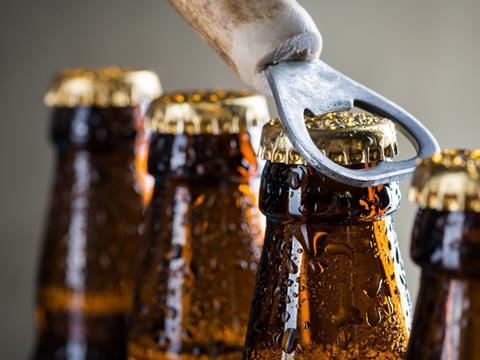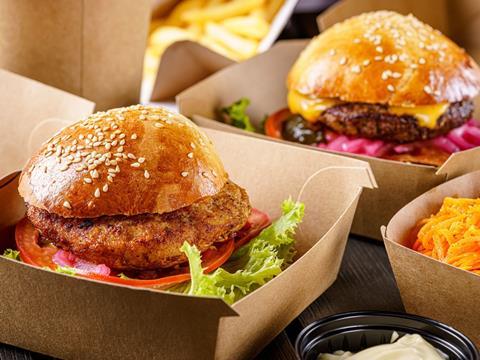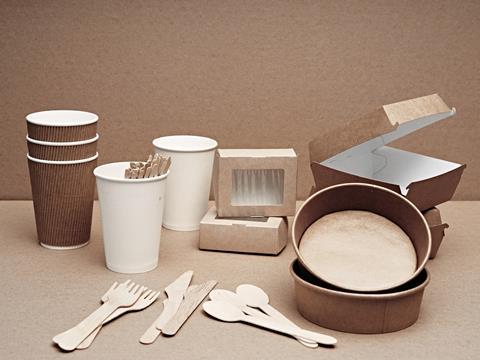
The European Commission’s Joint Research Centre has conducted a data-based study evaluating the environmental impacts of single-use and reusable food and beverage packaging in a range of materials and serving contexts – yet the Alliance for Sustainable Packaging for Foods (ASPF) cautions that it fails to consider the role of food preservation and safety in the pursuit of more sustainable packaging solutions.
A general overview
Reusable packaging has been raised by many as a solution to meeting the EU’s climate targets and cutting down on the environmental impacts of packaging. Product protection and transport are both reliant on packaging, as are certain products in the food, beverage, and pharmaceutical sectors, for example.
Yet companies, consumers, and policymakers alike are becoming more concerned about the generation of waste and overall life cycle impacts caused by their packaging consumption. Eurostat has calculated that individual EU inhabitants generated an estimated 177.9kg of packaging waste in 2020. At 32.7 million tonnes, most of the material waste generated since 2009 was thought to be made of paper and cardboard, followed by plastic at 15.5 million tonnes and glass at 15.2 million tonnes.
Since then, the JRC warns, the amount of single-use packaging generated has continued to increase, which is causing strain on the EU’s waste management system. Complex, multi-layered materials and a shortage of suitable management infrastructures have an impact on recyclate quality, which in turn impacts the amount of material that can be reincorporated into new packaging.
If reuse and recycling rates remain low, it is feared that the EU could fail to meet its own sustainability targets. An increase in reusable containers has been proposed as a potential improvement, but the paper argues that such processes as washing have previously been assumed, rather than proven, to benefit the environmental performance of a pack.
With the rise of takeaway and delivery food in recent years, especially during the COVID-19 pandemic, the problem of single-use packaging waste is becoming increasingly relevant. As such, the JRC zooms in on Article 26 of the Packaging and Packaging Waste Regulation, which lays out such targets as 20% of all hot or cold takeaway beverage packaging being sold in reusable packaging within a reuse or refill system by 1st January 2030; and HORECA distributors selling 10% of their take-away ready-prepared food products in reusable or refillable packaging within the same time frame.
Furthermore, by the start of 2030, 10% of packaging for beer, carbonated alcoholic beverages, fermented beverages except wine, aromatized wine products and fruit wine, products based on spirits, wine or other fermented beverages mixed with soda, cider, or juice should be sold in reusable packaging in a reuse or refill system.
5% of all wine, except for sparkling wine, sold on the EU market should also be sold in reusable packaging within a reuse or refill system by that time.
On top of that, the study consults Article 22, Annex V.3 of the Regulation, which indicates a complete transition into 100% reusable packaging in the dine-in HORECA sector.
As such, the European Commission’s Directorate-General for Environment has commissioned the JRC to weigh up the life cycle environmental performance of single-use and reusable packaging in line with the targets of the Packaging and Packaging Waste Regulation.
To examine the true environmental outcome of these rules, the study takes a life cycle assessment approach, modelling different single-use and reusable packaging scenarios in Microsoft Excel with a range of datasets. The results are Normalized and Weighted to calculate an EF Single Score, or an index enabling the different environmental impacts of products or scenarios to be evaluated as a whole.

Cups
‘Scenario 1’ compares the environmental performance of hot or cold beverage packaging served in a container at the point of sale for takeaway. Specifically, it weighs up the performance of a single-use carton cup with an LDPE lining and a carton lid, versus a reusable polypropylene cup with a polypropylene lid.
The results suggest that, in most categories, the reusable cup has a lower environmental impact. Despite the requirement to wash multi-use packaging, it is thought to use less water throughout its life cycle than single-use alternatives, which is largely due to the water consumption values attributed to cartonboard.
On the other hand, single-use packaging performed better in the contexts of climate change, ecotoxicity in freshwater, and resource use for metals, minerals, and fossils. The plastics manufacturing process and the passenger car required to return reusables to their point of sale are listed as reasons for this outcome.
The aggregated Single Score suggests that reusable packaging performs ‘slightly better’ overall. Sensitivity analysis indicates that, in around 40% of simulations, reusable packaging had a lower impact. The impacts were comparable in around 30% of the simulations, and the remaining 50% saw a lower impact for single-use.
A dedicated analysis has also been undertaken to analyze the environmental impact of cartonboard production using different datasets. The ‘Benchmark dataset’ – primary data collected in a facility, retrieved by the researchers during the stakeholder consultation, that is assumed to model electricity consumption based on the EU electricity mix – is compared to ‘Alternative 1’, which represents the EU’s average kraft pulping process data from 2012, and ‘Alternative 2’, or primary data that assumes an amount of electricity consumption claimed by the industry to be used in a facility.
In the impact category for water use, reusable packaging comes out on top in both the Benchmark and Alternative 1 datasets. This is not true of Alternative 2, in which single-use packaging is thought to be more efficient. The Single Score index demonstrates the importance of the cartonboard dataset selected, the researchers explain, with Alternative 2 demonstrating an improvement over the Benchmark dataset in both water use and climate change.
The aggregated Single Score results suggest that, in most of the simulations conducted, the impact of single-use packaging increases in the transition from the Benchmark to the Alternative 1 dataset. Alternative 2 is said to lead to improvement.
In the future, the JRC recommends that more data should be gathered to develop datasets that are as accurate to EU cartonboard production as possible, yet still align with the EF method and all remaining datasets.
Additionally, the researchers have weighed up the pros and cons of beverage container lids – both whether they should be included in the pack, and what kind of lid performs best. It compares a single-use cup utilizing a carton lid with low-density polyethylene lining; a single-use cup utilizing a polystyrene lid; and an alternative for both tests in which the cups did not have lids.
In all three cases, reusable packaging has less detrimental effects in the water use impact category, yet single-use demonstrates benefits in terms of climate change impact. The Single Score results suggest lower impacts for reusable packaging in the benchmark scenario than single-use, but the opposite is true when the cup does not have a lid. The researchers put this down to the different masses of the lids between the three scenarios and the impacts of manufacturing polystyrene and carton.
Life cycle impacts could potentially indicate that polystyrene lids have advantages, yet the researchers underline that these results do not factor in such environmental impacts as plastic litter in the environment. It also highlights the value of mono-material packaging as an easily recyclable option, and emphasize that, in their view, ‘the assumptions related to the lid in the scenarios are less relevant than other assumptions’.

Trays
‘Scenario 2’ is split into two case studies that examine the life cycle impacts of single-use and reusable packaging used in takeaway food applications. Both use a polypropylene clamshell tray as their reusable packaging sample, but Case A compares it to a single-use carton tray with LDPE lining and a reusable polypropylene clamshell, while Case B uses a single-use aluminium tray with LDPE lining.
Each case covers the whole life cycle of each tray. In Case A, the single-use packaging is revealed to have a lower impact in terms of climate change, ecotoxicity in freshwater, and mineral, metal, and fossil resource use, whereas the reusable packaging has a lower impact in the other product categories – this includes ozone depletion potential, cancer and non-cancer human toxicity, and both land and water use.
Once again, plastics manufacturing and the return process drive up the impacts of reusable packaging in this case. The benchmark results underline that, even with its own water requirements, reusable packaging still requires less water use than single-use packaging; and the aggregated Single Score suggests that, overall, the polypropylene clamshell tray has a slightly lower environmental impact.
Sensitivity analysis simulations indicate that, in terms of the aggregated Single Score and impact categories like marine and terrestrial eutrophication, the single-use and reusable options are comparable. Around one-third of simulations reveal that single-use packaging has lower impacts in terms of aggregated Single Score alone – yet another third sees reusables perform better and the final third results in ‘comparable impacts’.
Around 60% of simulations produce lower impacts for single-use packaging than reusables; this is especially true of the impact categories for mineral, metal, and fossil resource use, as well as freshwater ecotoxicity. However, in all other impact categories, reusable packaging outperforms its single-use alternatives.
The report also investigates the impact of car transport on reusable packaging by removing the variable from the model. In this case, in all factors except freshwater ecotoxicity, reusable packaging becomes the less impactful option.
Compared to the even balance between single-use, reuse, and comparable results in the aggregated Single Score during sensitivity analysis, the removal of car transport factors reveals a lower impact for reusable packaging in most simulations, with similar improvements in particular impact categories like climate change.
The researchers highlight these results as indicative of the part assumptions about consumer behaviour can play in the true environmental value of takeaway packaging products, especially when it must be returned to the point of sale.
Their benchmark model assumes that 25% of trays are returned using the same home delivery service that originally provides the packaging, Within the remaining 75% it assumes that 90% is returned by foot, bicycle, or car when a consumer is undertaking another task on the same trip, such as shopping – the remaining 10% are thought to be returned via passenger car in a dedicated journey.
From this, it assumes that five trays are returned at once, and thus the environmental impacts are divided between the five items of packaging. Once again, though, the JRC recommends that more primary data is collected from business models currently in place to more accurately gauge their impacts.
Case B, meanwhile, looks at the life cycle of a takeaway single-use aluminium tray and a takeaway polypropylene tray. It reveals that reusable packaging has lower impacts for all categories except the uses of fossil, mineral, and metal resources, which are either comparable or lower for single-use, and the Benchmark indicates that the water use impacts for reusable packaging are lower than single-use alternatives.
The aggregated Single Score also indicates that the reusable pack delivers lower environmental impacts overall. However, around one-third of sensitivity analysis simulations result in a comparable outcome for single-use and reusable packaging products when it comes to climate change.

Cans and beer bottles
In ‘Scenario 3’, Case A compares the life cycle impacts of a single-use aluminium can and a reusable plastic bottle. Aluminium production is said to have a noticeable impact on all the impact categories for single-use packaging – yet, especially in the cases of land use, freshwater eutrophication, and mineral and metal resource use, it is said to have resulted in lower environmental impacts. The aggregated Single Score produces lower environmental impact for the single-use pack.
Once again, the manufacture of plastic components for the reusable alternatives, the passenger car required to return the bottles, and the energy consumption required to wash reusable packaging play a part in this result.
On the other hand, the impacts of single-use packaging are higher in the water use impact category due to the amount of water required to produce aluminium. It is also more impactful in the acidification impact category. Reusable packaging is said to bring benefits when it comes to particulate matter, or particle pollution, and ionizing radiations, which can lead to radioactive contamination.
Still, the two packaging products are reportedly compatible when it comes to climate change impact. The aggregated Single Score suggests that the single-use packaging has lower impacts in around 50% of simulations, whereas 20% favour reusable packaging and 30% do not result in a comparable difference.
Meanwhile, Case B raises the examples of single-use and reusable glass beer bottles. The reusable bottle is expected to facilitate multiple uses due to its thickness in comparison to its single-use alternative.
Here the tests reveal that the reusable bottle performs better in almost every impact category, always totalling less than 60% of the impacts of the single-use bottle. So, too, does the Single Score suggest that the reusable option is more sustainable overall. Only the land use category indicates that single-use is the less harmful option.
In line with these findings, the sensitivity analysis observes lower impacts for reusable glass bottles across all categories except land use, while the Single Score finds lower impacts for reuse in over 95% of the simulation.
Wine bottles
In ‘Scenario 4’, the researchers examined the environmental impacts of wine bottles, excluding sparkling wine. Its case study focuses on a single-use glass bottle compared to a thicker, reusable glass bottle.
Much like the equivalent research surrounding beer bottles, the reusable wine bottle has lower impacts than its single-use alternative in every impact category except land use. Even in the sensitivity analysis, this remained the case, and the Single Score results corroborated that reusable packaging is the less impactful option.
The researchers assert that, at most, a reusable bottle reaches 60% of the environmental impact of its single-use alternative.

Dine-in meals
The ‘Restaurant Scenario’ narrows its lens to the dine-in HORECA sector. It compares the value of single-use and reusable packaging options for a so-called ‘hamburger meal’.
In the single-use scenario, this involves a cup and two trays made of carton and lined with LDPE to serve a drink, hamburger, and fries. The reusable alternatives are made of polypropylene, constituting a cup and a plate to hold both the burger and fries. Neither of the drinks are served with lids.
When considering the benchmark values, reusable packaging has lower impacts than the single-use option in almost all impact categories. Even though reusable packaging requires water consumption, it is still the lower-impact option in the water use category, and the Single Score index implies that reusable packaging is less detrimental overall.
The sensitivity analysis aligns with these findings, revealing lower impacts for almost all impact categories in most of the simulations conducted. Over 60% of simulations resulted in a lower climate change impact for reusable packaging, and the aggregated Single Score was lower for reusables in around 90% of the simulations.
Only the categories for freshwater ecotoxicity and ionizing radiations favour single-use in the benchmark scenario or produce comparable impacts for single-use and reusable packaging options.
Once again, the Restaurant Scenario adds a sensitivity analysis in which alternative life cycle datasets to analyze cartonboard production. In this context, the differences are particularly stark between Alternatives 1 and 2 in the water use impact category.
Reusable packaging results in lower impacts across all the tested alternatives in the impact category for climate change and the aggregated Single Score. Nevertheless, the difference becomes less stark when the Alternative 2 dataset – the primary data of a facility’s assumed electricity consumption – is introduced. The water use impacts for single-use packaging also decrease in Alternative 2.
In a similar vein, reusable packaging delivers a less impactful outcome in the majority of sensitivity analysis simulations – except for water use in the Alternative 2 scenario, which once again results in an improved environmental performance for single-use.
A set of three additional scenarios have also been introduced by the researchers to establish the break-even point of the Restaurant Scenario. It examines the effects of assumptions surrounding end-of-life recycling of the single-use carton; the end-of-life recycling of the single-use carton paired with improved recycling at the end-of-life stage for polypropylene; and the number of reuses for the reusable polypropylene packs.
If, in the Benchmark dataset, the carton waste is recycled at a rate of 75%, it is expected that the single-use and reusable packaging will have a similar carbon footprint. Any higher and the single-use packaging has a lower carbon footprint. Therefore, the break-even point for the recycling rate of carton is expected to be reached at around 75% in this scenario.
In line with the EU’s average kraft pulping process data in Alternative 1, it is thought that the break-even point would be reached at a lower carton recycling rate of around 70%, influenced by the climate change impacts between this scenario and the Benchmark and the particular system boundaries for carton production within this dataset.
Alternative 2 brings the break-even point down to around 50%, which is also attributable to the associated climate change impacts. In this case, then, single-use packaging will have a lower carbon footprint than reusable packaging when the recycling rate of carton waste exceeds 50%.
The researchers suggest that utilizing low-impact cartonboard in single-use applications and pushing for higher recycling rates at end-of-life will improve the material’s environmental performance and potentially unlock lower impacts for single-use over reuse, even in dine-in applications. Even when the assumed recycling rate increase for polypropylene reusables is increased up to 85%, the break-even remains unchanged across all cartonboard datasets, the results claim.
On this note, the study also experiments with variations in the number of assumed reuses for the polypropylene dine-in packaging, ranging from five reuses to two hundred, against the different cartonboard manufacturing datasets. The break-even point is placed at around 20-30 reuses in the Benchmark cartonboard dataset, and when the reuse cycles increase, the reusables have a lower carbon footprint than single-use packaging products.
In Alternative 1, around 20 reuses are required to break even. Alternative 2 calls for around 40. Again, these are influenced by the variations in climate change impacts.

Key findings and response
In general, the study asserts that reusable packaging products could have a higher impact than single-use alternatives in situations where packaging must be transported back to a collection or selling point. The assumed number of reuses can also be a factor, and reuse schemes are broadly associated with high energy and water requirements, mostly due to washing processes.
Key assumptions and methodological choices that could further sway the environmental impact of reusables include the type and efficiency of washing machine used; the distance between the consumption point and the take-back point; what mode of transport is used to return the packaging; how many items of packaging are transported at once; and whether other tasks are undertaken during the return process, such as buying new food products on the same trip.
In weighing up cartonboard manufacturing, the researchers highlight that assuming datasets with lower impacts of cartonboard manufacturing results in a more favourable performance for single-use packaging, especially where water use is concerned. The impacts on climate change vary greatly between datasets and the researchers highlight that future analyses could utilize datasets that better represent the whole EU market and fully align with the EF method.
In response, the Alliance for Sustainable Packaging for Foods (ASPF) commends the JRC’s ‘science- and data-driven approach’, believing it can ‘serve as an example for approaching regulatory decision-making when environmental trade-offs are considered’.
Conversely, it believes that the impacts of food loss and waste have not been considered in the study. Inadequate packaging reportedly contributes to the environmental impact of lost or wasted food and is more detrimental to the environment than packaging itself. ASPF’s own position paper lays out the correlation between packaging and food safety.
It encourages regulators to consider technologies that offer alternatives to packaging. One example is functional Price-Look-Up (PLU) stickers, which are thumbnail-sized sticks applied directly to a product that grant consumers access to information about the origin of their food and relevant safety information.
It is the Alliance’s view that food safety, loss, and waste, as well as alternate technologies, should all play a part in the upcoming Packaging and Packaging Waste Regulation to ensure that a reduction in single-use packaging does not come at the expense of consumer health and safety.
As such, it discourages the removal of packaging for unprocessed fruits and vegetables under 1.5kg in weight and, until alternative solutions are found, urges the continued use of all functional stickers that negate the need for additional packaging. It also underlines the importance of considering safety factors when considering minimum recycled content quotas for food-contact packaging.
If you liked this story, you might also enjoy:
The Brief: How viable is biorecycling for plastics?
Report: How the top brands are progressing on packaging sustainability
The Brief: Using ocean-bound plastic in packaging – how, why and should we?












No comments yet